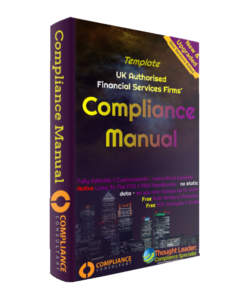No products in the cart.
Home/Book
Conduct Risk Book
£15.00
Even though the immediate priorities involved stabilising and repairing firms’ balance sheets and implementing liquidity and capital reforms, the regulators’ attention and resources are currently centred around the behaviour of firms, the culture they have embedded and exactly how they conduct their business.
This scrutiny or regulatory focus is effectively an assessment of culture within firms and this culture is demonstrated by the way firms conduct themselves in their own management and governance, product design, terms and conditions, sales process and support, post sales, and complaints.
![]()
Although managing risks has accelerated, mitigating conduct risk has become one of the highest priorities for regulators worldwide, a universally agreed concise explanation conduct risk does not, as yet, exist. In response to changing regulatory expectations compliance officers, risk as well as other senior managers at financial services firms are coming to terms with how to establish precisely what it means for their organisation and then to implement systems and controls to deal with the risks they have identified.![]()
Numerous surveys have been conducted devoted to finding out how the industry is defining and managing with conduct risk. Final results provide a snapshot of how developed and embedded current thinking and practices are. These are useful in the shorter term but as the Conduct Risk subject is a constantly shifting, developing and defining subject, newer thinking often overtakes previous methodology.
What is interesting is the responses from Africa, north and south America, Asia, Australasia, Europe along with the Middle East. They often represent firms from all over the financial services sector, including banks, insurers and fund managers, and some are sector specific.
The results reflect the wide and uncertain scope of current conduct risk thinking. There will always remain variations in how firms are defining conduct risk and similarly how various national regulators are referencing the concept. This emphasis on behaviour however universally incorporates fundamental and complex aspects including: corporate governance; the demonstrably fair treatment of retail customers; the strategy for the style and design, manufacture and selling of products; how staff are incentivized; and, perhaps most critically of all, as mentioned before, the firm’s approach to culture. The results from all these various polls serve to demonstrate significant disparity in approaches and in the focus provided for this developing concept, which can be unsurprising because of the ever-increasing wide variety of regulatory change, demands and priorities with which firms continue being faced. The delivery gap between the services thought to be provided by firms of all sizes, and the belief of those receiving those services has never been wider since the banking crisis started.
To be fair and accurate, not all regulators around the world have specifically badged conduct risk as such but their changing expectations and missives issued to firms by supervisors, and equally on supervisors by the supranational bodies and governments, with regard to risk culture are universal.![]()
Perhaps Conduct Risk should be re-badged as “Culture Risk”, as it may be better understood by all, except that culture would be even more far reaching and encompassing tradition, customs, ways of life and all these things that form the background for operations of the financial services world. Conduct Risk is what it says on the tin, concerning the conduct not only of individuals acting solely or in collusion, but also supervisors, middle and senior management and firms as a collective in the identification of customer’s needs, providing real solutions, priced fairly and made available for all. Additionally firms need to be able to identify risk from products and practices that are on the regulatory radar such as forbearance in the mortgage market, product design and oversight in the asset management sector, or cross selling in full service or investment banking groups.
The true measure of a successful conduct risk framework will be the risk-based assessment of the portfolio and scenario analysis, before adapting future product, service or distribution design and customer engagement strategies, taking action in relation to issues that arise before the regulators start to take notice.
Challenges of conduct risk are broad in scope and depth. While these challenges are important and must be met, there is another inherent challenge that the FCA has laid down for regulated firms, and this is a challenge that many have faced in one form or another over the years, and many have often failed to meet, however with few penalties.
That challenge is how to bring together a whole array of processes, people and data to create a culture that is focused on delivering customer outcomes just as much as it is focused on executing a trade or making a sale.
Shaping the culture of the firm is the real and most significant challenge that every firm regulated by the FCA is going to have to meet. Any technological solution has a number of characteristics and capabilities that need to work together to support the changing and sustaining of a new culture. Furthermore, any solution should enable the firm to deploy individual human capital scorecards across the firm. By using personal objectives and KPIs the firm can create clear performance expectations and remove any uncertainty an individual may have about what they are expected to deliver and achieve in the new organisation.



Reviews
There are no reviews yet.